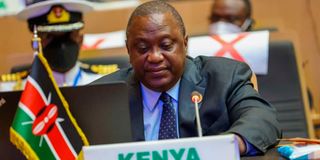Kenya Sh24 billion short in battle to end malaria

President Uhuru Kenyatta presents the 2021 Alma Malaria Progress Report at the 35th Ordinary Session of the Assembly of Heads of State and Government of the African Union in Addis Ababa, Ethiopia, in February.
Kenya is facing a Sh24 billion deficit to implement new innovations and interventions to end malaria, even as it grapples with 3.5 million new clinical cases and over 10,000 deaths from the disease each year.
The World Health Organization (WHO) recommends that malaria-endemic countries establish new strategies and alternative vaccines to eradicate the disease, saying, domestic spending has stalled or reduced for most countries. Malaria financing is heavily reliant on external sources.
High out-of-pocket health payments often create challenges to accessing services and coming up with new innovations.
Kenya and Tanzania are classified as low-income economies with heavy dependency on external financing for malaria with proximity to the equator giving the countries a favourable climate for high-level malaria transmission. In this financial year, the government has allocated Sh16.2billion for malaria, Aids and tuberculosis.
President Uhuru Kenyatta, who is Africa’s head of the Africa Leaders Malaria Alliance (Alma), has said it is time to stop fully depending on development partners and increase domestic funding for malaria.
Malaria strategic plans
“Malaria kills an estimated 600,000 people in Africa, mostly children under the age of five. About 63 percent of activities in national malaria strategic plans are currently unfunded,” President Kenyatta said. Mr Kenyatta is in talks with the Global Fund to have them continue offering support for malaria.
Mr Chris Getonga, chairman of the End Malaria Council, has called for more government allocation to the malaria kitty. The council, which was launched last year, sought new ways of sourcing funds and even benchmarked other countries like Zambia.
“As a country, we continue to hugely depend on donor funding, which is not sustainable,” said Mr Getonga. The End Malaria Council has reached out to willing entrepreneurs in the private sector to boost the kitty, assuring them of transparency and accountability.
“It was clear that many people and firms were willing to support malaria control efforts as long as our processes and systems were transparent and accountable. They also wish to see support directly benefit those with the greatest need,” he said.
Global Fund currently provides 56 percent total funding for malaria services in Africa.
“This will ensure that countries deploy next-generation interventions, diagnostics and vaccines,” said Dr Willis Akhwale, an Alma senior advisor.
Vaccine Alliance
The board of Gavi, the Vaccine Alliance last year approved $155.7 million in funding to support the malaria vaccine introduction, procurement and delivery for countries in sub-Saharan Africa between 2022 and 2025. Even then, Kenya continues to make progress in the fight against HIV, TB, and malaria. Malaria prevalence among children under five declined from eight in 2016 to six in 2020.
More than one million children in Kenya, Ghana and Malawi have received at least one dose of the historic Mosquirix (RTS, S) malaria vaccine that was first recommended by WHO last October. Kenya has so far administered 900, 000 doses of the vaccine which is given in four doses; the first at six months and the last at 24 months.
In a statement, acting Director-General for Health Patrick Amoth said the country still records about 3.5 million new clinical cases and over 10,000 deaths each year, with the people living in western Kenya having an especially high risk of malaria infection.
“This clearly shows us that we are still far from reaching our goal of being a malaria free country. Malaria is a drain on livelihoods and our economy, keeping children out of school and adults out of work ,” Dr Amoth said.
Dr Diallo pointed out that Kenya is among 29 countries that account for 96 per cent of global malaria deaths. The WHO says that, in addition to the approved RTS, S, other malaria vaccine candidates such as R21/Matrix-M need to be fast-tracked so as to have alternatives.
Clinical trials
“The successful completion of clinical trials for these vaccines will be important to assess their safety and efficacy profiles. WHO also welcomes the news from BioNTech, manufacturer of the Pfizer-BioNTech Covid-19 vaccine, that it aims to develop a malaria vaccine using mRNA technology,” said WHO in a statement. New forms of technology used in controlling mosquitoes that cause malaria have also been backed by the WHO. One such technology that is being piloted in Kenya is the attractive targeted sugar baits technology.
Since most of the interventions are found indoors, researchers are now trying to fight the mosquitoes from outside using the ATSB technology which is being piloted in Siaya County. Additionally, spatial repellents, which work by releasing chemicals that alter mosquito’s behaviour, are also the next big thing should they get approval from the WHO.
Researchers are also working on new malaria drugs. The most recent approval is the single-dose drug called Kozenis (tafenoquine) which was approved by the Australian Therapeutic Goods Administration.
However, there are still pressing issues like drug resistance that the WHO say need new strategies to tackle the problem.
“Innovation in tools and strategies will be critical to containing these threats, together with a more strategic use of the tools that are available today,” said the WHO.
Since the President’s launch of the first-ever Malaria Youth Army last year, the health ministry has recruited about 150 Kenyan youths, most of whom are from the endemic regions, to educate people on malaria. The youths are drawn from 47 counties.






